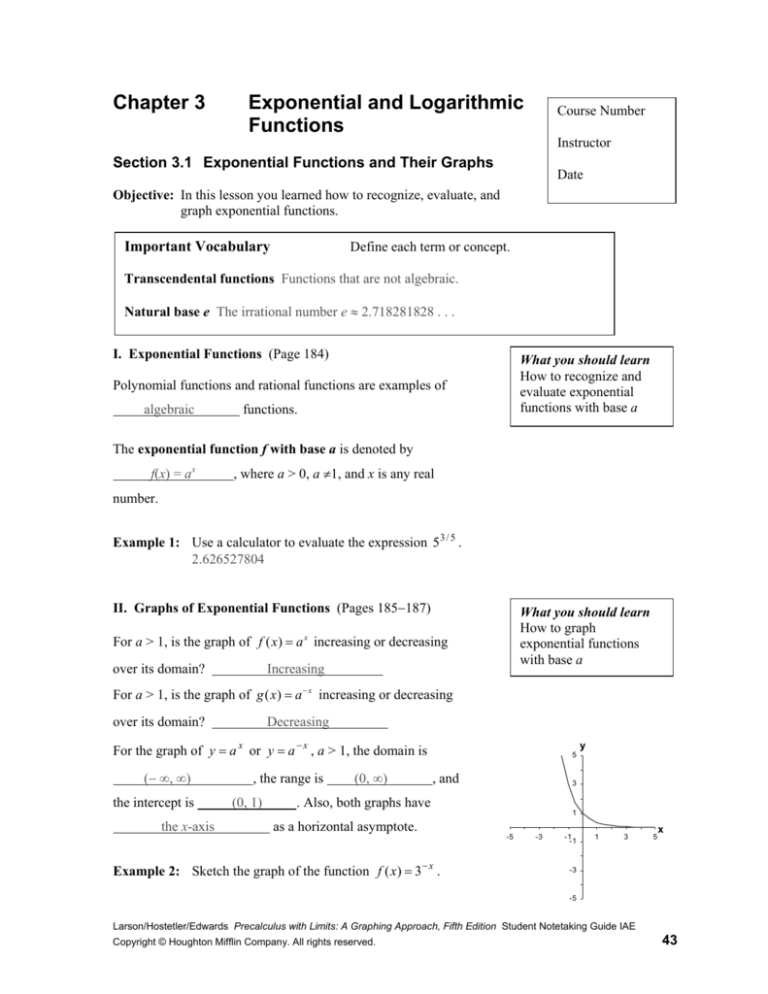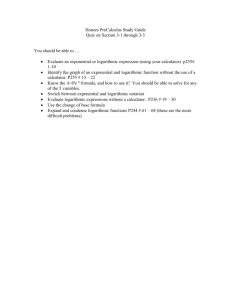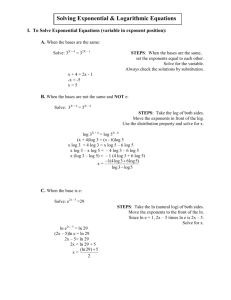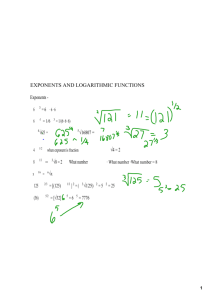
Chapter 3
Exponential and Logarithmic
Functions
Course Number
Instructor
Section 3.1 Exponential Functions and Their Graphs
Date
Objective: In this lesson you learned how to recognize, evaluate, and
graph exponential functions.
Important Vocabulary
Define each term or concept.
Transcendental functions Functions that are not algebraic.
Natural base e The irrational number e ≈ 2.718281828 . . .
I. Exponential Functions (Page 184)
What you should learn
How to recognize and
evaluate exponential
functions with base a
Polynomial functions and rational functions are examples of
algebraic
functions.
The exponential function f with base a is denoted by
f(x) = ax
, where a > 0, a ≠1, and x is any real
number.
Example 1: Use a calculator to evaluate the expression 5 3 / 5 .
2.626527804
II. Graphs of Exponential Functions (Pages 185−187)
What you should learn
How to graph
exponential functions
with base a
For a > 1, is the graph of f ( x) = a x increasing or decreasing
over its domain?
Increasing
For a > 1, is the graph of g ( x) = a − x increasing or decreasing
over its domain?
Decreasing
For the graph of y = a x or y = a − x , a > 1, the domain is
(− ∞, ∞)
the intercept is
the x-axis
, the range is
(0, 1)
(0, ∞)
5
, and
3
. Also, both graphs have
as a horizontal asymptote.
Example 2: Sketch the graph of the function f ( x) = 3 − x .
y
1
-5
-3
-1
-1
1
3
5
x
-3
-5
Larson/Hostetler/Edwards Precalculus with Limits: A Graphing Approach, Fifth Edition Student Notetaking Guide IAE
Copyright © Houghton Mifflin Company. All rights reserved.
43
44
Chapter 3
Exponential and Logarithmic Functions
III. The Natural Base e (Pages 187−189)
What you should learn
How to recognize,
evaluate, and graph
exponential functions
with base e
The natural exponential function is given by the function
f(x) = ex
.
Example 3: Use a calculator to evaluate the expression e 3 / 5 .
1.8221188
For the graph of f ( x) = e x , the domain is
the range is
(0, ∞)
(− ∞, ∞)
, and the intercept is
(0, 1)
,
.
The number e can be approximated by the expression
(1 + 1/x)x
for large values of x.
IV. Applications (Pages 190−192)
After t years, the balance A in an account with principal P and
annual interest rate r (in decimal form) is given by the formulas:
For n compoundings per year:
A = P(1 + r/n)nt
For continuous compounding:
A = Pert
What you should learn
How to use exponential
functions to model and
solve real-life problems
Example 4: Find the amount in an account after 10 years if
$6000 is invested at an interest rate of 7%,
(a) compounded monthly.
(b) compounded continuously.
(a) $12,057.97
(b) $12,082.52
Homework Assignment
Page(s)
Exercises
Larson/Hostetler/Edwards Precalculus with Limits: A Graphing Approach, Fifth Edition Student Notetaking Guide IAE
Copyright © Houghton Mifflin Company. All rights reserved.
Section 3.2
45
Logarithmic Functions and Their Graphs
Course Number
Section 3.2 Logarithmic Functions and Their Graphs
Instructor
Objective: In this lesson you learned how to recognize, evaluate, and
graph logarithmic functions.
Important Vocabulary
Date
Define each term or concept.
Common logarithmic function The logarithmic function with base 10.
Natural logarithmic function The logarithmic function with base e given by
f(x) = ln x, x > 0.
I. Logarithmic Functions (Pages 196−197)
The logarithmic function with base a is the
inverse
of the exponential function f ( x) = a x .
function
What you should learn
How to recognize and
evaluate logarithmic
functions with base a
The logarithmic function with base a is defined as
f(x) = loga x
, for x > 0, a > 0, and a ≠ 1, if and
only if x = ay. The notation “ log a x ” is read as “
log
.”
base a of x
The equation x = ay in exponential form is equivalent to the
equation
y = loga x
in logarithmic form.
When evaluating logarithms, remember that a logarithm is a(n)
exponent
. This means that log a x is the
to which a must be raised to obtain
x
exponent
.
Example 1: Use the definition of logarithmic function to
evaluate log 5 125 .
3
Example 2: Use a calculator to evaluate log10 300 .
2.477121255
Larson/Hostetler/Edwards Precalculus with Limits: A Graphing Approach, Fifth Edition Student Notetaking Guide IAE
Copyright © Houghton Mifflin Company. All rights reserved.
46
Chapter 3
Exponential and Logarithmic Functions
Complete the following properties of logarithms:
1) log a 1 =
0
3) log a a x =
x
2) log a a =
1
a log a x =
x
and
4) If log a x = log a y , then
x=y
.
Example 3: Solve the equation log 7 x = 1 for x.
x=7
II. Graphs of Logarithmic Functions (Pages 198−199)
For a > 1, is the graph of f ( x) = log a x increasing or decreasing
over its domain?
What you should learn
How to graph logarithmic
functions with base a
Increasing
For the graph of f ( x) = log a x , a > 1, the domain is
(0, ∞)
, the range is
the intercept is
, and
.
(1, 0)
Also, the graph has
(− ∞, ∞)
as a vertical
the y-axis
asymptote. The graph of f ( x) = log a x is a reflection of the
graph of f ( x) = a x in
the line y = x
.
Example 4: Sketch the graph of the function f ( x) = log 3 x .
5
y
3
1
-5
-3
-1
-1
1
3
5
x
-3
-5
Larson/Hostetler/Edwards Precalculus with Limits: A Graphing Approach, Fifth Edition Student Notetaking Guide IAE
Copyright © Houghton Mifflin Company. All rights reserved.
Section 3.2
III. The Natural Logarithmic Function (Pages 200−202)
Complete the following properties of natural logarithms:
1) ln 1 =
3) ln e x =
47
Logarithmic Functions and Their Graphs
0
x
4) If ln x = ln y , then
2) ln e =
and
x=y
e ln x =
1
What you should learn
How to recognize,
evaluate, and graph
natural logarithmic
functions
x
.
Example 5: Use a calculator to evaluate ln 10 .
2.302585093
Example 6: Find the domain of the function f ( x) = ln( x + 3) .
(−3, ∞)
IV. Applications of Logarithmic Functions (Page 202)
Describe a real-life situation in which logarithms are used.
Answers will vary.
What you should learn
How to use logarithmic
functions to model and
solve real-life problems
Example 7: A principal P, invested at 6% interest and
compounded continuously, increases to an amount
K times the original principal after t years, where t
ln K
. How long will it take the
is given by t =
0.06
original investment to double in value? To triple in
value?
11.55 years; 18.31 years
Larson/Hostetler/Edwards Precalculus with Limits: A Graphing Approach, Fifth Edition Student Notetaking Guide IAE
Copyright © Houghton Mifflin Company. All rights reserved.
48
Chapter 3
Exponential and Logarithmic Functions
Additional notes
y
y
x
y
y
x
y
x
x
y
x
x
Homework Assignment
Page(s)
Exercises
Larson/Hostetler/Edwards Precalculus with Limits: A Graphing Approach, Fifth Edition Student Notetaking Guide IAE
Copyright © Houghton Mifflin Company. All rights reserved.
Section 3.3
49
Properties of Logarithms
Course Number
Section 3.3 Properties of Logarithms
Objective: In this lesson you learned how to rewrite logarithmic
functions with different bases and how to use properties of
logarithms to evaluate, rewrite, expand, or condense
logarithmic expressions.
I. Change of Base (Page 207)
Let a, b, and x be positive real numbers such that a ≠ 1 and b ≠ 1.
The change-of-base formula states that . . .
loga x can be converted to a different base using any of the
following formulas:
Base b: loga x = (logb x)/(logb a)
Base 10: loga x = (log10 x)/(log10 a)
Base e: loga x = (ln x)/(ln a)
Instructor
Date
What you should learn
How to rewrite
logarithms with different
bases
Explain how to use a calculator to evaluate log 8 20 .
Using the change-of-base formula, evaluate either
(log 20) ÷ (log 8) or (ln 20) ÷ (ln 8). The results will be the same:
1.4406
II. Properties of Logarithms (Page 208)
Let a be a positive number such that a ≠ 1; let n be a real
number; and let u and v be positive real numbers. Complete the
following properties of logarithms:
1. log a (uv) =
2. log a
u
=
v
3. log a u n =
What you should learn
How to use properties of
logarithms to evaluate or
rewrite logarithmic
expressions
loga u + loga v
loga u − loga v
n loga u
III. Rewriting Logarithmic Expressions (Page 209)
To expand a logarithmic expression means to . . . .
use the
properties of logarithms to rewrite complicated products,
quotients, and exponential forms into simpler sums, differences,
What you should learn
How to use properties of
logarithms to expand or
condense logarithmic
expressions
and products.
Example 1: Expand the logarithmic expression ln
ln x + 4 ln y − ln 2
xy 4
.
2
Larson/Hostetler/Edwards Precalculus with Limits: A Graphing Approach, Fifth Edition Student Notetaking Guide IAE
Copyright © Houghton Mifflin Company. All rights reserved.
50
Chapter 3
To condense a logarithmic expression means to . . . .
Exponential and Logarithmic Functions
use the
properties of logarithms to rewrite the expression as the
logarithm of a single quantity.
Example 2: Condense the logarithmic expression
3 log x + 4 log( x − 1) .
log[x3(x − 1)4]
IV. Applications of Properties of Logarithms (Page 210)
One way of finding a model for a set of nonlinear data is to take
the natural log of each of the x-values and y-values of the data
set. If the points are graphed and fall on a straight line, then the
x-values and the y-values are related by the equation:
ln y = m ln x
What you should learn
How to use logarithmic
functions to model and
solve real-life problems
, where m is the slope of the
straight line.
Example 3: Find a natural logarithmic equation for the
following data that expresses y as a function of x.
x
2.718
7.389
20.086
54.598
y
7.389
54.598
403.429
2980.958
ln y = 2 ln x
or ln y = ln x2
y
y
x
y
x
x
Homework Assignment
Page(s)
Exercises
Larson/Hostetler/Edwards Precalculus with Limits: A Graphing Approach, Fifth Edition Student Notetaking Guide IAE
Copyright © Houghton Mifflin Company. All rights reserved.
Section 3.4
51
Solving Exponential and Logarithmic Equations
Section 3.4 Solving Exponential and Logarithmic Equations
Objective: In this lesson you learned how to solve exponential and
logarithmic equations.
I. Introduction (Page 214)
State the One-to-One Property for exponential equations.
ax = ay if and only if x = y
Course Number
Instructor
Date
What you should learn
How to solve simple
exponential and
logarithmic equations
State the One-to-One Property for logarithmic equations.
loga x = loga y if and only if x = y
State the Inverse Properties for exponential equations and for
logarithmic equations.
aloga x = x
and
loga ax = x
Describe some strategies for using the One-to-One Properties
and the Inverse Properties to solve exponential and logarithmic
equations.
•
•
•
Rewrite the original equation in a form that allows the
use of the One-to-One Properties of exponential or
logarithmic functions.
Rewrite an exponential equation in logarithmic form and
apply the Inverse Property of logarithmic functions.
Rewrite a logarithmic equation in exponential form and
apply the Inverse Property of exponential functions.
1
for x.
3
(b) Solve 5 x = 0.04 for x.
(a) x = 2 (b) x = − 2
Example 1: (a) Solve log 8 x =
II. Solving Exponential Equations (Pages 215−216)
Describe how to solve the exponential equation 10 x = 90
algebraically.
Take the common logarithm of each side of the equation and
then use the Inverse Property to obtain: x = log 90. Then use a
calculator to approximate the solution by evaluating log 90 ≈
1.954.
What you should learn
How to solve more
complicated exponential
equations
Larson/Hostetler/Edwards Precalculus with Limits: A Graphing Approach, Fifth Edition Student Notetaking Guide IAE
Copyright © Houghton Mifflin Company. All rights reserved.
52
Chapter 3
Exponential and Logarithmic Functions
Example 2: Solve e x − 2 − 7 = 59 for x. Round to three decimal
places.
x ≈ 6.190
III. Solving Logarithmic Equations (Pages 217−219)
Describe how to solve the logarithmic equation
log 6 ( 4 x − 7) = log 6 (8 − x) algebraically.
What you should learn
How to solve more
complicated logarithmic
equations
Use the One-to-One Property for logarithms to write the
arguments of each logarithm as equal: (4x − 7) = (8 − x). Then
solve this resulting linear equation by adding 7 to each side,
adding x to each side, and then finally dividing both sides by 5.
The solution is x = 3.
Example 3: Solve 4 ln 5 x = 28 for x. Round to three decimal
places.
x ≈ 219.327
Describe a method that can be used to approximate the solutions
of an exponential or logarithmic equation using a graphing
utility.
Use a graphing utility to graph the left side of the equation as y1
and the right side of the equation as y2. Use the intersect feature
or the zoom and trace features to approximate the intersection
point.
IV. Applications of Solving Exponential and Logarithmic
Equations (Page 220)
Example 4: Use the formula for continuous compounding,
A = Pe rt , to find how long it will take $1500 to
triple in value if it is invested at 12% interest,
compounded continuously.
t ≈ 9.155 years
What you should learn
How to use exponential
and logarithmic equations
to model and solve reallife problems
Homework Assignment
Page(s)
Exercises
Larson/Hostetler/Edwards Precalculus with Limits: A Graphing Approach, Fifth Edition Student Notetaking Guide IAE
Copyright © Houghton Mifflin Company. All rights reserved.
Section 3.5
53
Exponential and Logarithmic Models
Section 3.5 Exponential and Logarithmic Models
Objective: In this lesson you learned how to use exponential growth
models, exponential decay models, Gaussian models, logistic
models, and logarithmic models to solve real-life problems.
Important Vocabulary
Course Number
Instructor
Date
Define each term or concept.
Bell-shaped curve The graph of a Gaussian model.
Logistic curve A model for describing populations initially having rapid growth
followed by a declining rate of growth.
Sigmoidal curve Another name for a logistic growth curve.
I. Introduction (Page 225)
y = aebx, b > 0
The exponential growth model is
y = ae–bx, b > 0
The exponential decay model is
−(x−b)2 /c
The Gaussian model is
y = ae
The logistic growth model is
Logarithmic models are
y = a + b log10 x
.
.
y = a/(1 + be−rx)
y = a + b ln x
.
What you should learn
How to recognize the five
most common types of
models involving
exponential or
logarithmic functions
.
and
.
II. Exponential Growth and Decay (Pages 226−228)
Example 1: Suppose a population is growing according to the
model P = 800e 0.05t , where t is given in years.
(a) What is the initial size of the population?
(b) How long will it take this population to
double?
(a) 800
(b) 13.86 years
What you should learn
How to use exponential
growth and decay
functions to model and
solve real-life problems
To estimate the age of dead organic matter, scientists use the
carbon dating model R = 1/1012 e−t/8245
, which
denotes the ratio R of carbon 14 to carbon 12 present at any time
t (in years).
Example 2: The ratio of carbon 14 to carbon 12 in a fossil is
R = 10−16. Find the age of the fossil.
Approximately 75,737 years old
Larson/Hostetler/Edwards Precalculus with Limits: A Graphing Approach, Fifth Edition Student Notetaking Guide IAE
Copyright © Houghton Mifflin Company. All rights reserved.
54
Chapter 3
Exponential and Logarithmic Functions
III. Gaussian Models (Page 229)
The Gaussian model is commonly used in probability and
statistics to represent populations that are
distributed
normally
.
What you should learn
How to use Gaussian
functions to model and
solve real-life problems
y
On a bell-shaped curve, the average value for a population is
where the
maximum y-value
of the function occurs.
x
Example 3: Draw the basic form of the graph of a Gaussian
model.
IV. Logistic Growth Models (Page 230)
Give an example of a real-life situation that is modeled by a
logistic growth model.
Answers will vary. One possibility is a bacteria culture that is
initially allowed to grow under ideal conditions, and then under
less favorable conditions that inhibit growth.
What you should learn
How to use logistic
growth functions to
model and solve real-life
problems
y
Example 4: Draw the basic form of the graph of a logistic
growth model.
V. Logarithmic Models (Page 231)
Example 5: The number of kitchen widgets y (in millions)
demanded each year is given by the model
y = 2 + 3 ln( x + 1) , where x = 0 represents the year
2000 and x ≥ 0. Find the year in which the number
of kitchen widgets demanded will be 8.6 million.
In 2008
x
What you should learn
How to use logarithmic
functions to model and
solve real-life problems
Homework Assignment
Page(s)
Exercises
Larson/Hostetler/Edwards Precalculus with Limits: A Graphing Approach, Fifth Edition Student Notetaking Guide IAE
Copyright © Houghton Mifflin Company. All rights reserved.
Section 3.6
55
Nonlinear Models
Course Number
Section 3.6 Nonlinear Models
Objective: In this lesson you learned how to fit exponential,
logarithmic, power, and logistic models to sets of data.
I. Classifying Scatter Plots (Page 237)
When faced with a set of data to be modeled, what is a good first
step in selecting which type of model will best fit the data?
Instructor
Date
What you should learn
How to classify scatter
plots
Making a scatter plot of the data.
II. Fitting Nonlinear Models to Data (Pages 237−239)
Describe how to use a graphing utility to fit a nonlinear model to
data.
Answers will vary. For instance, enter the paired data into a
graphing utility and graph the data. Use this scatter plot to decide
what type of model would fit the data best. Then use the
regression feature of the graphing utility to find the appropriate
model, either quadratic, exponential, power, or logarithmic.
Graph the data and the model in the same viewing window to see
whether the model is a good fit to the data. If deciding among
several models, compare the coefficients of determination for
each model. The model whose r2-value is closest to 1 is the
model that best fits the data.
What you should learn
How to use scatter plots
and a graphing utility to
find models for data and
choose a model that best
fits a set of data
Example 2: Find an appropriate model, either logarithmic or
exponential, for the data in the following table.
x
y
1
1.120
3
2.195
y = 0.8(1.4)x or
5
4.303
7
8.433
9
16.529
y = 0.8e0.336x
Larson/Hostetler/Edwards Precalculus with Limits: A Graphing Approach, Fifth Edition Student Notetaking Guide IAE
Copyright © Houghton Mifflin Company. All rights reserved.
56
Chapter 3
Exponential and Logarithmic Functions
III. Modeling With Exponential and Logistic Functions
(Pages 240−241)
Example 3: Find a logistic model for the data in the following
table.
0
5
x
y
10
27
y=
15
50
20
73
25
88
What you should learn
How to use a graphing
utility to find exponential
and logistic models for
data
30
95
99.88
1 + 19.67e−0.199x
Additional notes
y
y
x
y
x
x
Homework Assignment
Page(s)
Exercises
Larson/Hostetler/Edwards Precalculus with Limits: A Graphing Approach, Fifth Edition Student Notetaking Guide IAE
Copyright © Houghton Mifflin Company. All rights reserved.








